Small Modular Reactors (SMR's) in Virginia
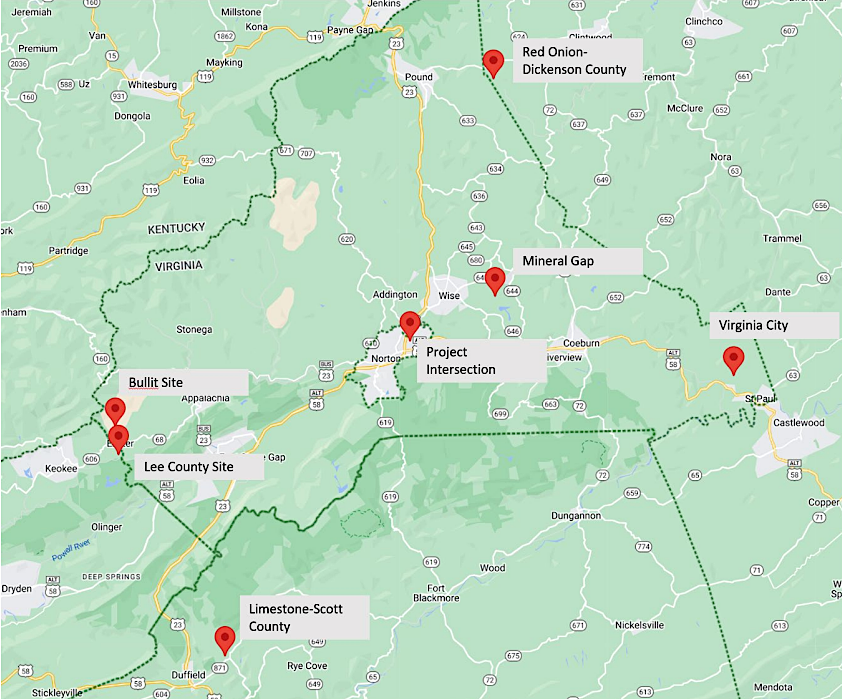
a 2023 study identified seven possible sites for small modular reactors in the Region of Interest (ROI) in Southwest Virginia, the LENOWISCO Planning District
Source: LENOWISCO Planning District Commission, SMR Site Feasibility Study for LENOWISCO (Figure 4-20)
In theory, small modular reactors (SMR's) are a cost-effective way to provide reliable baseload electricity. In contrast to electricity generated at solar and wind facilities, nuclear facilities deliver electricity 24 hours/day, 7 days/week. SMR's are one way for utilities to meet the requirement in the Virginia Clean Economy Act (VCEA) that 100% of
Virginia's electricity come from carbon-free sources by 2050.
The US Department of Energy champions small modular reactors:1
- Advanced SMRs offer many advantages, such as relatively small physical footprints, reduced capital investment, ability to be sited in locations not possible for larger nuclear plants, and provisions for incremental power additions. SMRs also offer distinct safeguards, security and nonproliferation advantages.
The per-megawatt cost of Small Modular Reactors will remain unknown until enough units are completed to evaluate the track record and project the future reliably. Large reactors built since the 1970's took advantage of the economy of scale, but design changes and associated delays from regulatory reviews resulted in massive cost overruns compared to planned expenses. In theory, private corporations and utilities can standardize on just one or a few designs for Small Modular Reactors and built them in factories on assembly lines the same way modern airplanes are manufactured. oversight agencies can approve projects quickly, reducing h high risk of costs exceeding benefits.
However, it may take until 2050 for the streamlining that theoretically will reduce the costs of smaller reactors to offset the economies of scale. A 2020 assessment concluded:2
- The International Energy Agency and Nuclear Energy Agency argue that global nuclear capacity will need to double by 2050 to meet aggressive climate targets and match growing demand for energy... This implies adding roughly 400 GW of new nuclear capacity and another 200 GW to replace retiring units. Most of the new capacity will likely come from large reactors, but if just 25 percent comes from SMRs that will equate to 2500 60 MW reactors or 100,000 1.5 MW reactors — large enough volumes to experience significant learning by doing and cost reduction.
- While SMRs and microreactors are considered appropriate for niche markets today, this analysis shows that with significant volume, there is potential for their cost to decline enough to be competitive with large nuclear power plants. With targeted policies and fast learning rates, SMRs could reach cost parity with fossil fuels before 2050.
Governor Glenn Youngkin, a Republican elected in 2021, heavily criticized the Virginia Clean Economy Act that was passed by the Democratic-controlled General Assembly and signed by Governor Ralph Northam in 2020. Youngkin objected to both the planned reliance to generate electricity at solar and wind facilities and the requirement to shut down facilities powered by coal and natural gas.
When he issued his 2022 Energy Plan ten months after taking office, Governor Youngkin called for an "all of the above approach," He proposed to extend the life of generating plants powered by fossil fuels, and called for a nuclear "moon shot" to build at least one small modular reactor:3
- The Plan supports funding to initiate the goal of deploying a commercial SMR in Southwest Virginia within ten years.

building small reactors based on a standard design could be a cost-effective alternative to large nuclear reactors, with their history of massive construction cost overruns
Source: US Department of Energy, Advanced Reactor Technology Development Fact Sheet
Local jurisdictions in the LENWISCO Planning District welcomed the potential economic development associated with new generation facilities, including potential data centers that needed the electricity. The property taxes would also be beneficial.
In 2023, a site feasibility study examined possible locations for SMR's in a "Region of Interest" that included Lee, Scott, Wise, and Dickenson counties plus the independent City of Norton. All of those jurisdictions except Dickenson were part of the LENOWISCO Planning District:4
- This geographic region of Southwest Virginia is characterized by the availability of brownfield sites for development, minewater for cooling, rail lines for shipping, and an interest in energy generation and data center development.
The contractor conducting the site feasibility study used the Siting Tool for Advanced Nuclear Development (STAND) approach that had been adopted by the Nuclear Regulatory Commission. The final report identified seven specific possible locations for a small modular reactor, while acknowledging others may also be suitable.
The electricity could be consumed in Southwest Virginia. Former strip mines provided multiple already-flattened locations for building data centers located far enough away from residents that noise and visual impacts would not be a concern, in contrast to Northern Virginia. Otherwise, there were high voltage transmission lines nearby so reactors could export power into the grid.
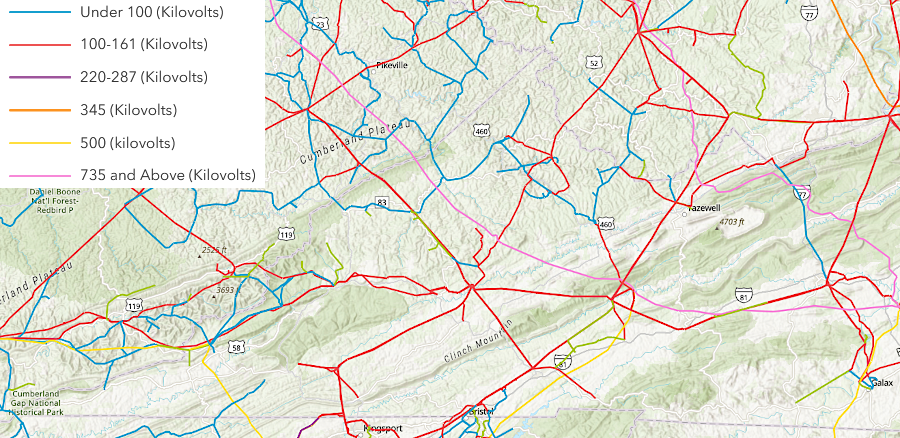
transmission lines in Southwest Virginia would acilitate exporting electricity from small modular reactors to the grid
Source: ESRI, ArcGIS Online
Local officials were supportive of the possibility of placing a small modular reactor on any of the seven sites in Southwest Virginia. New electricity generating plants would convert former coal mines and other brownfield sites into employment centers generating property taxes. According to the LENOWISCO Executive Director, the STAND analysis concluded:5
- We were either equal to or better than all the sites in the United States. I mean we're as competitive as anywhere.
The seven sites were:6
- Bullitt Mine site
- The 4,000-acre former coal mine site was near the town of Appalachia in Wise County. It was flat, with few environmental constraints after previous mining use. Millions of gallons of geothermally-cooled 51°F water that had filled the underground mining tunnels and could be used for cooling water. One challenge was that the honeycomb of underground tunnels created the risk of ground instability.
- Lee County site
- This 10-acre site, being reclaimed from coal mining operations in 2023, was across Virginia Route 606 from the old Bullitt mine. Water in flooded underground coal shafts and nearby Lake Keokee both offered cooling water. The Lee County site offered the potential for using both sites to build a complex of small modular reactors and data centers that would consume the electricity.
-
- Limestone site, Scott County
- The 4-acre site near Duffield in Scott County was formerly an underground limestone mine. The mine opened after the South Atlantic and Ohio Railroad built its track through the area in 1909, and closed in 1971. Inside the mine, temperature was a steady 51°F. A small modular reactor (or data center) there could take advantage of the natural geothermal cooling.
-
- Virginia City Hybrid Energy Center, Wise County
- This site was occupied by Dominion Energy's operating generation facility, producing much as 610 megawatts of electricity from burning "gob" coal, wood waste, and freshly-mined coal. It was not scheduled to close until 2045.
-
- Mineral Gap and Project Intersection sites, Wise County
- The Mineral Gap industrial park (Lonesome Pine Regional Business and Technology Park) is next to Lonesome Pine Airport in Wise County. The Project Intersection industrial park is a former 188-acre surface coal mine site at the intersection of US23 and US Alt 58 in Norton. It was redeveloped using funding from the Abandoned Mined Land Pilot Program and other economic development sources. Wise, Lee, Scott and Dickenson counties and Norton partnered to create the Lonesome Pine Regional Industrial Facilities Authority and develop the Project Intersection site.
-
- Red Onion site, Dickenson County
- This former coal mining site in Dickenson County is being developed into a 30-acre industrial park by the Dickenson County Industrial Development Authority.
-
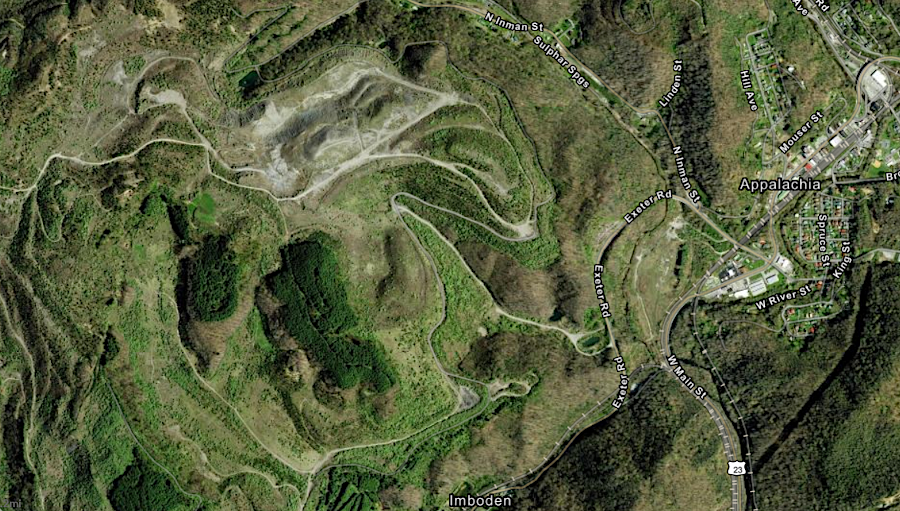
the Bullitt Mine site offered 4,000 acres for developing multiple small modular reactors and possibly data centers
Source: ESRI, ArcGIS Online
Building one or more small modular reactors at the Mineral Gap and Project Intersection industrial parks generated the strongest public response. Because of the small size of available development pads and the proximity to the City of Norton and existing development in Wise County, microreactors generating just 20MW were proposed there.
Nuclear reactors in submarines were comparable to microreactors. "Small" modular reactors would be larger, generating 50-300 megawatts. In January 2025, GO Virginia awarded a $100,000 planning grant to the LENOWISCO Planning District Commission to identify a prospective site for a microreactor in Wise County.
The vice-president of the Clinch Coalition, a local environmental group, commented that:7
- ...in the press that local officials were giving and some of the reassurances we were hearing was that these [SMRs] will be put on former surface mines, but in very isolated places nowhere near population centers. Our county administrator even told The Washington Post that they were not going to be in anybody's backyard or something similar in a piece last February. Then, all of a sudden this report came out and two were literally in backyards.
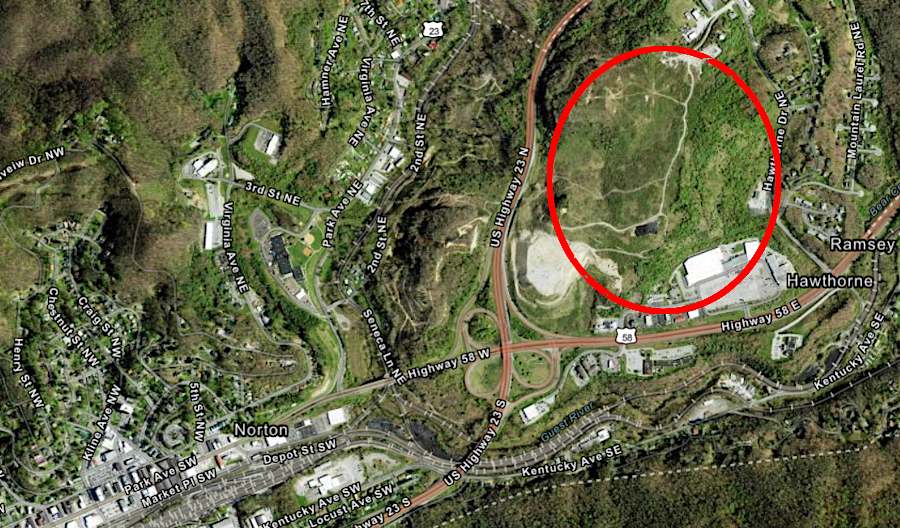
20MW microreactors were proposed at the Project Intersection industrial park
Source: ESRI, ArcGIS Online
In March 2024, Governor Youngkin retreated from his October 22 statement that the first small modular reactor would be located in Southwest Virginia. While visiting Abingdon, he suggested that other places might be more suitable.
The editor of Cardinal News had already noted that the governor was not in charge of site selection. The US Department of Energy had suggested the site of the Clover coal plant in Halifax County, in Southside Virginia on the other side of the Blue Ridge from Southwest Virginia, might be the best location.
Virginia's two investor-owned utilities sector would determine where to build any small modular reactor, though state and Federal agencies could block such a proposal:8
- The governor is a cheerleader, not a decider on this one. It's utilities - which have to work through regulatory agencies - that pick the locations for energy sites, nuclear or otherwise.
The 2024 General Assembly passed SB454, which allowed utilities to charge ratepayers for pre-construction costs up to $1.40/month per customer. Dominion Energy could issue contracts for planning and design up to that limit.
Investors owning the company's stock would see no risk to profits by considering construction of a small modular reactor; ratepayers would cover all planning costs. State legislators guaranteed the company could recover its investment through a "rider" that increased customer rates, which the legislation ensured would be approved by the Virginia State Corporation Commission. Corporate profits would be unaffected if the utility decided to abandon the project and no small modular reactor ever went into service.
On July 10, 2024, Dominion Energy released a Request for Proposals (RFP) for a contractor to evaluate the feasibility of placing a small modular reactor in Louisa County. It would be placed on the grounds of the North Anna nuclear power plant, not in Southwest Virginia.9
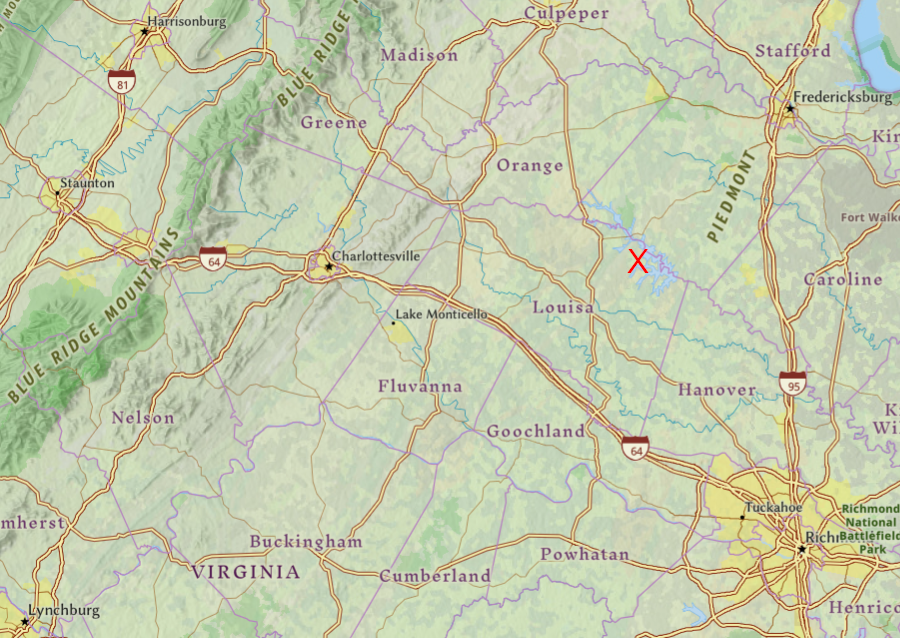
in 2024, Dominion Energy proposed locating a small modular reactor in Louisa County at the North Anna Power Plant (red X)
Source: ESRI, ArcGIS Online
Dominion Energy filed a new Integrated Resource Plan (IRP) with the State Corporation Commission on October 15, 2024. The company projected that demand for electricity would grow at a 5.5% annual rate over the next 15 years, and proposed adding 27GW of new generation capacity in order to meet the projected demand for 45GW in 2039. Data centers in Virginia required 2.8GW in 2023, and were expected to require 13GW in 2038.
In addition to building 3.4GW of offshore wind, 12GW of solar, 4.5GW of battery storage, and 6GW of natural gas capacity in an "all of the above" approach to generation, Dominion Energy proposed building five 268MW small modular reactors to produce a total of 1.34GW starting in 2035. That was 5% of the total new generation that the company was planning over the next 15 years.
In the transmission network, each substation connected to a data center can provide 300MW. By 2024, each new data center building required 60-90 megawatts, and multiple buildings were often planned for a data center "campus." Five new 268MW small modular reactors would not be sufficient to supply electricity to the proposed Prince William Digital Gateway project.
A day later, Dominion Energy announced that it had signed a memorandum of understanding with Amazon to develop and finance small modular reactors. Amazon was building data centers that required new generation, and obtaining it from a nuclear power plant would minimize greenhouse gas emissions. Nationwide, Amazon sought to create 5GW of generation capacity from small modular reactors by 2039. Each reactor was expected to cost $1 billion.
The first, in the Pacific Northwest, would be based on a reactor design developed by X-Energy. Google chose a design developed by Kairos Power. Neither design had been approved by the US Nuclear Regulatory Commission; at the time, only NuScale had an approved design. Utah Associated Municipal Power Systems had planned to start construction in 2025 to build small modular reactors based on the NuScale VOYGR SMR design for the Carbon Free Power Project at the Idaho National Laboratory, but cancelled the project in 2023 due to the high cost.
Microsoft chose another route to obtain carbon-free nuclear power, proposing to fund the reopening of the Three Mile Island nuclear power plant in Pennsylvania. Microsoft also contracted with Helion Energy to build a nuclear fusion power plant by 2028. Separately, Bill Gates invested in TerraPower with plans for a new facility in Wyoming. TerraPower's Natrium design relied upon liquid metal to transfer heat from the reactor, and separated the nuclear and non-nuclear components into two "islands." Construction on the 345MW reactor's non-nuclear components began in 2024, with completion expected (after reactor design approval by the US Nuclear Regulatory Commission) in five years.
In the July 10, 2024 announcement about Amazon building small modular reactors in Virginia, US Senator Mark Warner said that company was the largest power user in the United States. Referring to the Amazon Web Services (AWS) subsidiary, Virginia Business reported:10
- From 2011 to 2021, AWS invested more than $51.9 billion in Virginia, including building data centers. In January 2023, the company had at least 65 data centers in Loudoun in operation or under development, out of more than 200 data centers in the county, and AWS announced it planned to invest $35 billion by 2040 to build more data center campuses across the state.
Though Dominion Energy was making plans for small modular reactors to meet just 5% of the projected increase in demand for electricity, elected officials emphasized the positive when providing comments for Amazon's announcement. US Senator Tim Kaine said:11
- I'm glad Dominion and Amazon have come to this exciting agreement to diversify our clean energy options... From offshore wind to nuclear energy, Virginia is well positioned to be a leader in energy innovation and job creation. I will continue to do all that I can to make sure we are harnessing that opportunity, including by encouraging other companies to utilize the clean energy incentives in the Inflation Reduction Act that I'm proud to have helped pass.
On November 14, 2024, Appalachian Power announced plans to submit a proposal to the State Corporation Commission for building a small modular reactor. The chosen location was company-owned property in Campbell County on the James River, downstream from Lynchburg.
The small modular reactor would be close to Moumt Athos, where Framatome and BWXT had nuclear research and manufacturing facilities. A particular advantage of the site, in addition to anticipated local support, was that it was adjacent to the Joshua Falls substation on the existing 765 KV transmission line.12
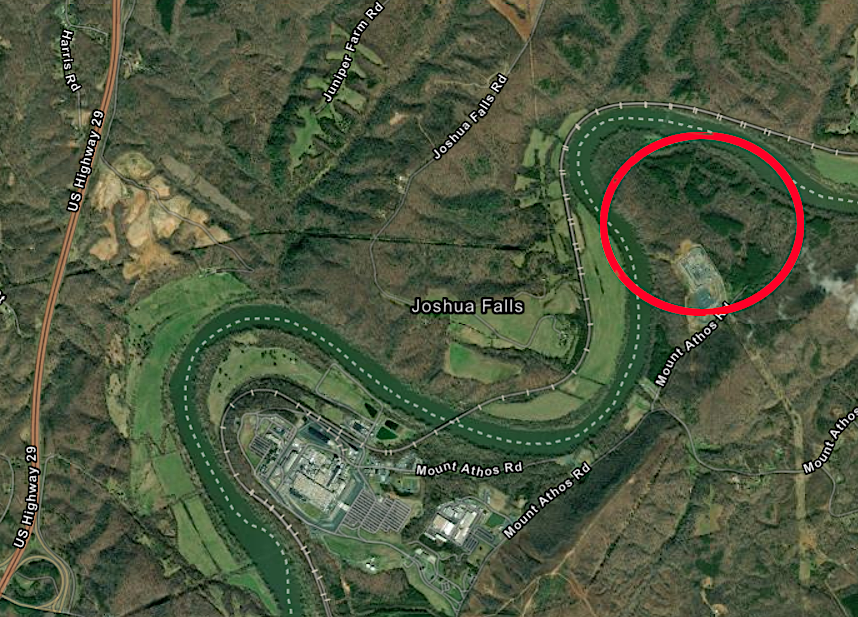
Appalachian Power proposed to build its first small modular reactor in Virginia next to the substation at Joshua Falls, downstream from the nuclear research and manufacturing facilities at Mount Athos
Source: ESRI, ArcGIS Online
Links
- Appalachian Power
- Cardinal News
- Idaho National Laboratory
- International Atomic Energy Agency
- NuScale Power
- Virginia Department of Energy
- US Department of Energy
References
1. "Advanced Small Modular Reactors (SMRs)," US Department of Energy, https://www.energy.gov/ne/advanced-small-modular-reactors-smrs (last checked October 24, 2023)
2. Jessica R. Lovering, Jameson R. McBride, "Chasing Cheap Nuclear: Economic Trade-Offs for Small Modular Reactors," The Bridge, Fall 2020, https://lwrs.inl.gov/Technical%20Integration%20Office/Nuclear_Energy_Revisited.pdf#page=40 (last checked November 20, 2023)
3. "2022 Virginia Energy Plan," Virginia Department of Energy, 2022, p.2, https://energy.virginia.gov/public/documents/2022_Virginia_Energy_Plan.pdf; "Youngkin slams Virginia plan for wind, solar; calls for nuclear push," Washington Post, October 10, 2022, https://www.washingtonpost.com/dc-md-va/2022/10/03/virginia-youngkin-nuclear-energy-plan/ (last checked October 24, 2023)
4. "SMR Site Feasibility Study for LENOWISCO," LENOWISCO Planning District, April 2023, p.xii, https://energy.virginia.gov/renewable-energy/documents/FINAL%20LENOWISCO%20SMR%20Feasibility%20Study%20-%20DEI%2020230520%20.pdf (last checked October 24, 2023)
5. "7 sites were studied as potential locations for a small modular reactor in Southwest Virginia. Here’s a closer look," Cardinal News, October 23, 2023, https://cardinalnews.org/2023/10/23/7-sites-were-studied-as-potential-locations-for-a-small-modular-reactor-in-southwest-virginia-heres-a-closer-look/ (last checked October 24, 2023)
6. "SMR Site Feasibility Study for LENOWISCO," LENOWISCO Planning District, April 2023, p.xii, https://energy.virginia.gov/renewable-energy/documents/FINAL%20LENOWISCO%20SMR%20Feasibility%20Study%20-%20DEI%2020230520%20.pdf; "7 sites were studied as potential locations for a small modular reactor in Southwest Virginia. Here’s a closer look," Cardinal News, October 23, 2023, https://cardinalnews.org/2023/10/23/7-sites-were-studied-as-potential-locations-for-a-small-modular-reactor-in-southwest-virginia-heres-a-closer-look/; "Virginia City Hybrid Energy Center," Dominion Energy, https://www.dominionenergy.com/projects-and-facilities/coal-and-oil-facilities/vchec; "Project Intersection-Lonesone Pine Regional Industrial Facilities Authority" application, Virginia Association of Counties Achievement Awards, 2020, p.4, https://www.vaco.org/wp-content/uploads/2020/07/WiseCountyProjectIntersection.pdf; "Project Intersection demonstrates impact of regional cooperation in Southwest Virginia," TimesNews, February 28, 2021, https://www.timesnews.net/project-intersection-demonstrates-impact-of-regional-cooperation-in-southwest-virginia/article_5206ec6c-7a3c-11eb-a2be-9f7a923fd428.html (last checked October 25, 2023)
7. "Advocates worry residents are being left out of conversations about where to build Virginia’s first small nuclear reactor," Cardinal News, October 24, 2023, https://cardinalnews.org/2023/10/24/advocates-worry-residents-are-being-left-out-of-conversations-about-where-to-build-virginias-first-small-nuclear-reactor/; "Funding approved to study placing nuclear microreactor in Wise County," Cardinal News, January 16, 2025, https://cardinalnews.org/2025/01/16/funding-approved-to-study-building-nuclear-microreactor-in-wise-county/ (last checked January 16, 2025)
8. "A reality check on a small nuclear reactor in Southwest Virginia (or anywhere else)," Cardinal News, March 26, 2024, https://cardinalnews.org/2024/03/26/a-reality-check-on-a-small-nuclear-reactor-in-southwest-virginia-or-anywhere-else/ (last checked July 10, 2024)
9. "Dominion Energy takes important step to determine feasibility of Small Modular Reactor (SMR) technology to support customers' needs," Dominion Energy, July 10, 2024, https://news.dominionenergy.com/2024-07-10-Dominion-Energy-takes-important-step-to-determine-feasibility-of-Small-Modular-Reactor-SMR-technology-to-support-customers-needs;
Dominion seeking small nuclear reactor proposals," Virginia Mercury, July 11, 2024, https://virginiamercury.com/2024/07/11/dominion-seeking-small-nuclear-reactor-proposals/; "SB 454 Electric utilities; recovery of development costs associated with small modular reactor," Virginia General Assembly, 2024, https://lis.virginia.gov/cgi-bin/legp604.exe?ses=241&typ=bil&val=sb454 (last checked July 11, 2024)
10. "Amazon, Dominion Energy teaming up to develop small-scale nuclear reactors in Virginia," Washington Business Journal, October 16, 2024, https://www.bizjournals.com/washington/inno/stories/profiles/2024/10/16/amazon-dominion-energy-modular-reactor-nuclear.html; "Amazon Backs Massive Nuclear SMR Deployment: 5 GW with X-Energy, Agreements With Energy Northwest, Dominion," Power, October 16, 2024, https://www.powermag.com/amazon-backs-massive-nuclear-smr-deployment-5-gw-with-x-energy-agreements-with-energy-northwest-dominion/; "As data centers grow, Amazon and Dominion explore small nuclear reactors," Virginia Business, October 16, 2024, https://www.virginiabusiness.com/article/as-data-centers-grow-amazon-and-dominion-explore-nuclear-development/; "Amazon doubles down on nuclear energy with deal for small reactors," Washington Post, October 16, 2024, https://www.washingtonpost.com/business/2024/10/16/amazon-smr-nuclear/; "Idaho SMR project terminated," World Nuclear News, November 9, 2023, https://www.world-nuclear-news.org/Articles/Idaho-SMR-project-terminated; "Hungry for Energy, Amazon, Google and Microsoft Turn to Nuclear Power," New York Times, October 16, 2024, https://www.nytimes.com/2024/10/16/business/energy-environment/amazon-google-microsoft-nuclear-energy.html; "TerraPower Begins Construction on Advanced Nuclear Project in Wyoming," TerraPower, June 10, 2024, https://www.terrapower.com/terrapower-begins-construction-in-wyoming; "Dominion pushes for renewables, more natural gas in latest long-term plan," Virginia Mercury, October 16, 2024, https://virginiamercury.com/2024/10/16/dominion-pushes-for-renewables-more-natural-gas-in-latest-long-term-plan/ (last checked October 17, 2024)
11. "Dominion Energy and Amazon to explore advancement of Small Modular Reactor (SMR) nuclear development in Virginia," Dominion Energy., October 16, 2024, https://news.dominionenergy.com/2024-10-16-Dominion-Energy-and-Amazon-to-explore-advancement-of-Small-Modular-Reactor-SMR-nuclear-development-in-Virginia,1 (last checked October 16, 2024)
12. "Appalachian Power plans small modular nuclear reactor in Campbell County," Cardinal News, November 14, 2024, https://cardinalnews.org/2024/11/14/appalachian-power-plans-small-modular-nuclear-reactor-in-campbell-county/; "Appalachian Power Explores Small Modular Reactors To Meet Future Energy Demand In Virginia," Appalachian Power, November 14, 2024, https://appalachianpowersmr.com/news; "Local lawmakers rally behind AEP's Joshua Falls nuclear reactor project," News & Advance,
December 28, 2024, https://newsadvance.com/news/small-modular-reactor-appalachian-power-mark-peake-wendell-walker/article_7a78ec44-c23c-11ef-860a-ab302b49adc1.html (last checked January 1, 2025)
Energy
Virginia Places






